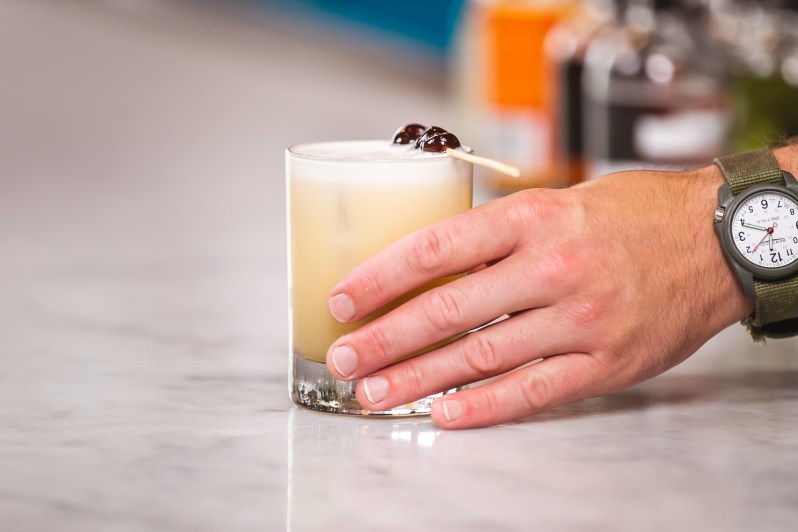
In the world of bartending, egg whites are transformative. They can also be intimidating, a little tricky to extract, and subject to blanket health concerns that don’t necessarily apply so long as you’re careful. But the mixology world has been making egg white cocktails for ages and for a good reason.
Egg whites do a number of things well beyond producing a balanced whiskey sour. They marry ingredients and smooth things out, making more angular elements like acid rounder and more approachable. They also add tremendous texture. Oh, and simply put, they often make cocktails look cool.
So, if you’re looking to bring some high-end bartending flair home to your own setup, start with some egg whites. We reached out to Mike Milligan at Four Seasons in Oahu. The veteran barkeep recently shed some light on his twists on five classic cocktails. It turns out that he loves using egg whites from behind the bar.
The rationale for using egg whites in cocktails

Use of egg whites in drinks goes way back. In fact, in the 17th Century, military types were adding them to punches for extra protein. In the mid-18th Century, the whiskey sour was concocted, immortalizing the use of egg whites in drinks. A drink called the Egg Flip was popular around the same time. People of the era were also known to make wassail, the hot yuletide beverage that sometimes took on egg whites.
Today, bartenders continue to use egg whites. You’ll find them woven into everything from a good Pisco Sour to a Ramos Gin Fizz. They’re used for presentation but also to shake up the chemistry of the drink itself, all in the pursuit of balance. Use too much, and the drink might stink. Use too little, and you won’t see much of a different. Use the right amount, and magic can unfold.
“I love using egg whites,” says Milligan. “They provide a sturdy mouthfeel and a creamy weightlessness, giving cocktails a lift. They battle acidity and sweetness, but not to the point of defeat. They are a bridge of clouds that citrus and sweetness can walk along together.”
Egg whites are dynamic, too, able to pair up with all kinds of other liquids. “The list of spirits where egg whites are at their best is long, and sours are my first choice,” he says. “Bourbon, rye, whiskey, Midori, Amaretto, tequila, mezcal, Absinthe — they all work.”
And they can even take on the big boys. “Intense flavors like Lagavulin 16 can make a delicious, peaty, smoky sour,” Milligan says. “Playing with different shrubs and acids only adds more complexity.”
How to use egg whites in cocktails

“As far as how to extract, I use the old fashioned way,” says Milligan of getting at the egg whites. Use a flat surface to break shell “and scale style back and forth using halved shell to separate yolk from white,” he adds. He insists on using fresh eggs (he take advantage of some local Hawaiian eggs). “Whipping or dry shaking all ingredients except spirits gives me the best effervescent foam,” he says.
Once the foam is set, Milligan adds his spirit of choice and shakes vigorously with ice. Per his mention, only use fresh eggs. If anything smells off when extracting the whites, discard it, as it’s likely spoiled. There’s an old legend that a fresh egg will sink when placed in water, whereas an outdated one will float. If there’s any concern at all, go with a pasteurized egg and start small. You don’t need tons of egg whites to reap the benefits.
There’s some cool science at play, as with most things. Blending alcohol with egg whites breaks up the proteins a bit, shaking up the makeup and causing coagulation. You know what’s taking place when the whites — actually more of a clear to begin with — turn that foamy white. This is when you reach that cloud-like quality Milligan mentions.
And if eggs aren’t your thing — whether it be allergies or otherwise — consider a substitute like aquafaba or gum syrup.
Mike’s template for egg white cocktails

Milligan has a template he relies on when making sours involving egg whites. Check it out below, and start mixing up some luxe drinks at home.
Ingredients:
- 2 ounces choice spirit
- 3/4-1 ounce choice shrub
- 3/4-1 ounce choice acid
- 1-2 egg whites
- Choice bitters
- Choice garnish
- Choice aromatic enhancement to cover raw egg nose
Method:
- Follow Mike’s dry shake/wet shake method above.
- Strain into appropriate glass and garnish.
Don’t stop there. Check out our favorite spring cocktails and feature on the Hawaiian rum renaissance. The days are getting longer, and the masses are getting thirstier. And don’t forget about great mocktail recipes, as they can take on egg whites and other ingredients well, too.


